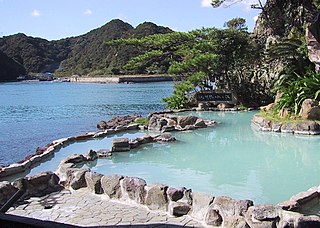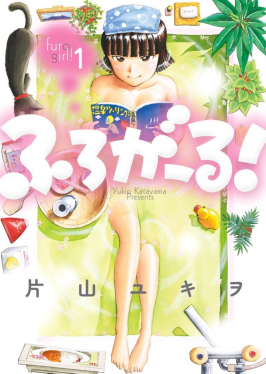
A sauna is a room or building designed as a place to experience dry or wet heat sessions, or an establishment with one or more of these facilities. The steam and high heat make the bathers perspire. A thermometer in a sauna is typically used to measure temperature; a hygrometer can be used to measure levels of humidity or steam. Infrared therapy is often referred to as a type of sauna, but according to the Finnish sauna organizations, infrared is not a sauna.

A towel is a piece of absorbent cloth or paper used for drying or wiping a surface. Towels draw moisture through direct contact.

A bathroom is a room in which people wash their bodies or parts thereof. It can contain one or more of the following plumbing fixtures: a shower, a bathtub, a bidet, and a sink. The inclusion of a toilet is common. There are also specific toilet rooms, only containing a toilet, which in North American English tend to be called "bathrooms", "powder rooms" or "washrooms", as euphemisms to conceal their actual purpose, while they in British and Irish English are known as just "toilets" or possibly "cloakrooms" - but also as "lavatories" when they are public.

In Japan, onsen are hot springs and the bathing facilities and traditional inns around them. There are approximately 25,000 hot spring sources throughout Japan, and approximately 3,000 onsen establishments use naturally hot water from these geothermally heated springs.

Washing is a method of cleaning, usually with water and soap or detergent. Regularly washing and then rinsing both body and clothing is an essential part of good hygiene and health.

Sentō (銭湯) is a type of Japanese communal bathhouse where customers pay for entrance. Traditionally these bathhouses have been quite utilitarian, with a tall barrier separating the sexes within one large room, a minimum of lined-up faucets on both sides, and a single large bath for the already washed bathers to sit in among others. Since the second half of the 20th century, these communal bathhouses have been decreasing in numbers as more and more Japanese residences now have baths. Some Japanese find social importance in going to public baths, out of the theory that physical proximity/intimacy brings emotional intimacy, which is termed skinship in pseudo-English Japanese. Others go to a sentō because they live in a small housing facility without a private bath or to enjoy bathing in a spacious room and to relax in saunas or jet baths that often accompany new or renovated sentōs.

A ryokan is a type of traditional Japanese inn that typically features tatami-matted rooms, communal baths, and other public areas where visitors may wear nemaki and talk with the owner. Ryokan have existed since the eighth century A.D. during the Keiun period, which is when the oldest hotel in the world, Nishiyama Onsen Keiunkan, was created in 705 A.D. Another old ryokan called Hōshi Ryokan was founded in 718 A.D. and was also known as the world's second oldest hotel. Such inns also served travelers along Japan's highways.

A shower is a place in which a person bathes under a spray of typically warm or hot water. Indoors, there is a drain in the floor. Most showers have temperature, spray pressure and adjustable showerhead nozzle. The simplest showers have a swivelling nozzle aiming down on the user, while more complex showers have a showerhead connected to a hose that has a mounting bracket. This allows the showerer to hold the showerhead by hand to spray the water onto different parts of their body. A shower can be installed in a small shower stall or bathtub with a plastic shower curtain or door. Showering is common due to the efficiency of using it compared with a bathtub. Its use in hygiene is, therefore, common practice.
Japanese bath may refer to:

Bathing is the immersion of the body, wholly or partially, usually in water, but often in another medium such as hot air. It is most commonly practised as part of personal cleansing, and less frequently for relaxation or as a leisure activity. Cleansing the body may be solely a component of personal hygiene, but is also a spiritual part of some religious rituals. Bathing is also sometimes used medically or therapeutically, as in hydrotherapy, ice baths, or the mud bath.

A bathtub, also known simply as a bath or tub, is a container for holding water in which a person or another animal may bathe. Most modern bathtubs are made of thermoformed acrylic, porcelain-enameled steel or cast iron, or fiberglass-reinforced polyester. A bathtub is placed in a bathroom, either as a stand-alone fixture or in conjunction with a shower.

Public baths originated when most people in population centers did not have access to private bathing facilities. Though termed "public", they have often been restricted according to gender, religious affiliation, personal membership, and other criteria.

A hot tub is a large tub full of water used for hydrotherapy, relaxation or pleasure. Some have powerful jets for massage purposes. Hot tubs are sometimes also known as "spas" or by the trade name Jacuzzi. Hot tubs may be located outdoors or indoors.

Etiquette in Japan forms common societal expectations of social behavior practiced throughout the nation of Japan. The etiquette of Japan has changed greatly over the millennia as different civilizations influenced its culture. Modern Japanese etiquette has a strong influence from that of China and the Western world, but retains many of its unique traditional elements.

The banya is a traditional Russian steam bath that utilizes a wood stove. It is a significant part of Russian culture, and is typically conducted in a small room or building designed for dry or wet heat sessions. The high heat and steam cause bathers to perspire.

Housing in Japan includes modern and traditional styles. Two patterns of residences are predominant in contemporary Japan: the single-family detached house and the multiple-unit building, either owned by an individual or corporation and rented as apartments to tenants, or owned by occupants. Additional kinds of housing, especially for unmarried people, include boarding houses, dormitories, and barracks.

Tea utensils are the tools and utensils used in chadō, the art of Japanese tea.

In a building or a ship, a room is any enclosed space within a number of walls to which entry is possible only via a door or other dividing structure. The entrance connects it to either a passageway, another room, or the outdoors. The space is typically large enough for several people to move about. The size, fixtures, furnishings, and sometimes placement of the room within the building or ship support the activity to be conducted in it.

Furo Girl! is a Japanese manga series written and illustrated by Yukio Katayama. It was serialized in Shogakukan's seinen manga magazine Big Comic Spirits from August 2015 to November 2016, with its chapters collected in three tankōbon volumes. The series depicts the lifestyle of a 25-year-old office worker and bath lover Sayoko Oyumino.
Chinese bathhouses have thousands of years of history and consist of numerous variations. The Chinese word for bathhouses in general is zǎotáng (澡堂); although in the stricter sense may refer to traditional, low-cost Chinese bathhouses to contrast with modern, upmarket Chinese bathhouses known as xǐyù zhōngxīn (洗浴中心) or just xǐyù (洗浴). Hot springs and spas are called wēnquán (温泉).






















